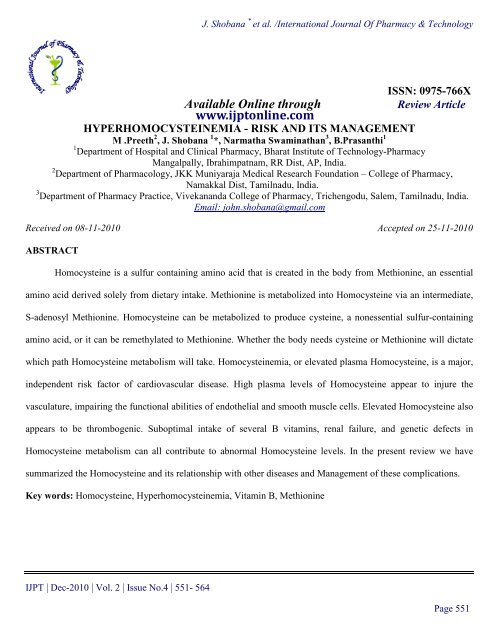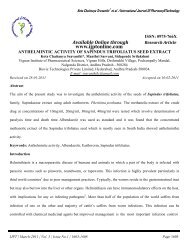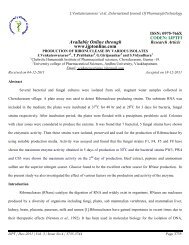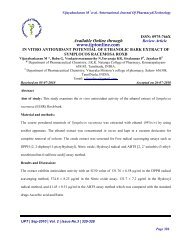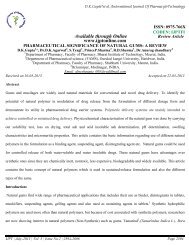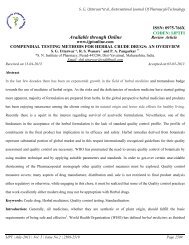Available Online through - International Journal of Pharmacy and ...
Available Online through - International Journal of Pharmacy and ...
Available Online through - International Journal of Pharmacy and ...
Create successful ePaper yourself
Turn your PDF publications into a flip-book with our unique Google optimized e-Paper software.
J. Shobana * et al. /<strong>International</strong> <strong>Journal</strong> Of <strong>Pharmacy</strong> & Technologyfindings, they have proposed that smoking might enhance the vasoconstrictor capacity in pregnant women byincreased tHcy concentrations <strong>and</strong> by a simultaneous decrease in the production <strong>of</strong> NO which is a vasodilatorcompound 5 .In another trial, they have been studied that the, plasma Hcy levels were significantly higher in smokingpatients than in control subjects. Additionally, they found out that the potential effect <strong>of</strong> cigarette smoking onplasma Hcy levels was found to be clearly dose dependent. In one <strong>of</strong> the case control trial, they have beensuggested that smokers with high plasma Homocysteine are at greatly increased risk <strong>of</strong> cardiovascular disease <strong>and</strong>should therefore be <strong>of</strong>fered intensive advice to help them cease smoking. They also have reduced levels <strong>of</strong> thoseB-vitamins (folate, vitamin B 6 <strong>and</strong> vitamin B 12 ) that modulate Homocysteine metabolism. While this finding mayreflect a direct effect <strong>of</strong> smoking or reduced B-vitamin intake, supplementation <strong>of</strong> these nutrients may beappropriate in smokers with high Homocysteine levels 6 .FoodVegetarians who do not supplement their diet with vitamin B 12 tend to have elevated Homocysteine levels.Elevated Homocysteine is associated with early mortality, heart disease, stroke, dementia, <strong>and</strong> birth defects.Vegetarians who get 3 to 100 µg <strong>of</strong> B 12 per day <strong>through</strong> fortified foods or supplements will minimize any elevatedHomocysteine problems due to a low B 12 intake. It is clear that most people with slightly elevated (or higher)Homocysteine levels can lower them <strong>through</strong> taking folate <strong>and</strong> vitamin B 12 . In 1998, the British Medical <strong>Journal</strong>published an analysis <strong>of</strong> 12 studies <strong>and</strong> concluded that folic acid in the range <strong>of</strong> 500-5,000 µg/day reducedHomocysteine by 25%, <strong>and</strong> that B 12 supplements (average intake <strong>of</strong> 500 µg /day) reduced it a further 7%. VitaminB 6 supplements (average <strong>of</strong> 16.5 mg/day) did not reduce Homocysteine further. 500 µg B 12 /day is a lot more thannecessary.In one study reported in the BMJ, only 100 µg B 12 /day (combined with folate <strong>and</strong> B 6 ) was successful inreducing Homocysteine from 7.2 - 5.8 µmol/l. In another, only 20 µg B 12 /day (combined with folate <strong>and</strong> B 6 )IJPT | Dec-2010 | Vol. 2 | Issue No.4 | 551- 564Page 553
J. Shobana * et al. /<strong>International</strong> <strong>Journal</strong> Of <strong>Pharmacy</strong> & Technologyresulted in reducing Homocysteine from 11.9 - 7.8 µmol/l. Vitamin B 12 deficiency were significantly higher invegetarians than those in occasional vegetarians <strong>and</strong> non- vegetarians. Therefore, maintaining a good vitamin B 12status should be emphasized for vegetarian’s subjects to avoid elevated Hcy levels. In addition, occasionalvegetarians had the lowest prevalence <strong>of</strong> Hyperhomocysteinemia <strong>and</strong> lower prevalence <strong>of</strong> vitamin B 2 or B 12insufficiency compared to non- vegetarians. 7AlcoholA number <strong>of</strong> observational studies have suggested an association between moderate alcohol consumption<strong>and</strong> tHcy concentrations, <strong>and</strong> an association between alcohol, folate <strong>and</strong> chronic disease risk has been observed.However, little r<strong>and</strong>omized trial evidence is available for examining the effect <strong>of</strong> alcohol on tHcy, <strong>and</strong>, inparticular, it remains to be conclusively determined whether the effect <strong>of</strong> alcohol on tHcy concentrations dependson the type <strong>of</strong> alcoholic beverage.It was observed that the Total Homocysteine (tHcy) is recognized as a CVD risk factor. It is elevated inpatients with chronic alcoholism <strong>and</strong> falls following alcohol withdrawal; therefore, alcohol may have a deleteriouseffect on health by raising tHcy levels. Homocysteine is regulated <strong>through</strong> a series <strong>of</strong> pathways, which aredependent on B vitamins, particularly folate 8 .In another study, it was assessed the effect <strong>of</strong> an 8-week intervention with vodka or red wine on plasmatHcy <strong>and</strong> B vitamin concentrations in healthy male volunteers. The intervention resulted in a decrease in folate <strong>and</strong>vitamin B 12 status <strong>and</strong> an increase in plasma tHcy. The effect <strong>of</strong> alcohol intervention on tHcy, folate <strong>and</strong> vitaminB 12 concentrations did not differ between the red wine <strong>and</strong> vodka intervention groups 9 .Genetic VariationSome people have elevated Homocysteine levels caused by a deficiency <strong>of</strong> B vitamins <strong>and</strong> folate in theirdiets. High Homocysteine levels are also seen in people with kidney disease, low levels <strong>of</strong> thyroid hormones,psoriasis, <strong>and</strong> with certain medications (such as antiepileptic drugs <strong>and</strong> Methotrexate). It has been recognized thatIJPT | Dec-2010 | Vol. 2 | Issue No.4 | 551- 564Page 554
J. Shobana * et al. /<strong>International</strong> <strong>Journal</strong> Of <strong>Pharmacy</strong> & Technologysome people have a common genetic variant (called methylenetetrahydr<strong>of</strong>olate reductase, abbreviated MTHFR)that impairs their ability to process folate. This defective gene leads to elevated levels <strong>of</strong> Homocysteine in somepeople who inherit MTHFR variants from both parents.Genetic mutations in MTHFR are the most commonly known inherited risk factor for elevatedHomocysteine levels. We all have 2 MTHFR genes, one inherited from each parent. Some people have a geneticmutation in one or both <strong>of</strong> their MTHFR genes. People with mutations in one MTHFR gene are called"heterozygous" for the MTHFR mutation; if mutations are present in both genes, the person is said to be"homozygous" for the mutation. The most common MTHFR mutation is called the MTHFR C677T mutation, or the"thermo labile" MTHFR mutation. Another common mutation is called MTHFR A1298C. To have any detrimentaleffect, mutations must be present in both copies <strong>of</strong> a person’s MTHFR genes.Studies have been conducted to investigate whether having 2 MTHFR mutations increases the risk <strong>of</strong> bloodclots in the arteries, blood clots in the veins, or CAD. This result suggested that the, so long as the Homocysteine10, 11level is normal, MTHFR mutations do not significantly increase the risk <strong>of</strong> heart attack or strokeComplications <strong>of</strong> HyperhomocysteinemiaEndothelial damageIncreased Hcy is associated with endothelial dysfunctions in healthy human. Hyperhomocysteinemia isconsidered to be a stronger risk factor for CHD in woman than men. An elevated blood level <strong>of</strong> Homocysteine isstrongly related to an increased risk <strong>of</strong> atherosclerosis <strong>and</strong> cardiovascular disease. The redox property <strong>of</strong> thesulfhydryl group <strong>of</strong> Hcy, leading to the formation <strong>of</strong> reactive oxygen species, such as superoxide <strong>and</strong> hydroxylradicals, is believed to play a pivotal role. On the other h<strong>and</strong>, increase in plasma Hcy leading to the transientdecrease in plasma cysteine, which is a substrate for NO production, may decrease the availability <strong>of</strong> endotheliumderivedrelaxing factor <strong>and</strong> the function <strong>of</strong> S-nitroso cysteine, a more potent vasodilator than endothelium-derivedIJPT | Dec-2010 | Vol. 2 | Issue No.4 | 551- 564Page 555
J. Shobana * et al. /<strong>International</strong> <strong>Journal</strong> Of <strong>Pharmacy</strong> & Technologyrelaxing factor. In addition Hcy may directly impair the NO pathway reducing NO elaboration by endothelial cells<strong>and</strong> increase oxidative degradation <strong>of</strong> NO 12 .HypertensionThe conditions <strong>of</strong> reduced NO production, such as in diabetes mellitus; a slight increase in Hcy might scavengeresidual endothelial NO <strong>and</strong> influence arterial regulatory tone. Recently a correlation between systolic bloodpressure <strong>and</strong> plasma Hcy has been demonstrated in a hypertensive geriatric population. However, studies whichexamine the association <strong>of</strong> hypertension <strong>and</strong> plasma Hcy levels do not seem adequate to reveal this relationclearly 13 .Multiple sclerosisMultiple sclerosis (MS) is a chronic inflammatory demylinating disease <strong>of</strong> central nervous system (CNS),with an onset typically between 20 <strong>and</strong> 40 years <strong>of</strong> age <strong>and</strong> more prevalent in women. Homocysteine may have aneurotoxin that activates N-methyl-D.aspartate receptor which leads to cell death. It may be converted intohomocysteic acid which also has a toxic effect on the neurons <strong>of</strong> cerebral cortex. So increased plasma level <strong>of</strong> totalHomocysteine (tHcy) has a neurodegenerative effect <strong>and</strong> may be a risk factor for progression <strong>of</strong> disability in MS.In one <strong>of</strong> the case control clinical trial, tHcy was compared between MS <strong>and</strong> Control group. It wasobserved that high serum tHcy is more in MS patients than healthy controls <strong>and</strong> significantly higher in the patientswith severe disability (EDSS≥3). So, serum tHcy may have a positive effect on Pathophysiology <strong>of</strong> MS 14Coagulation SystemHcy causes thrombotic tendency. Elevation <strong>of</strong> thromboxane A 2 formation (which may reflect plateletactivation), reduction <strong>of</strong> anti thrombin III activity (50% to 75% <strong>of</strong> normal) <strong>and</strong> activation <strong>of</strong> factor V, reduction <strong>of</strong>factor VII have been shown as the causes <strong>of</strong> increased coagulability in Hcy. A clot in the veins is called a venousthrombosis. Most <strong>of</strong>ten, venous thrombosis occurs in the legs; however, the clot can break away from the wall <strong>of</strong>the vein <strong>and</strong> travel to the lung, leading to a potentially fatal complication called pulmonary embolism. VenousIJPT | Dec-2010 | Vol. 2 | Issue No.4 | 551- 564Page 556
J. Shobana * et al. /<strong>International</strong> <strong>Journal</strong> Of <strong>Pharmacy</strong> & Technologyblood clots occur in approximately 1 in 1000 individuals per year. Certain studies have suggested that elevatedHomocysteine levels roughly double the risk <strong>of</strong> developing venous thrombosis 15 .Renal FailureHHcy is very frequent in renal failure, which suggests that the kidneys function is crucial for Hcycatabolism. Hcy is ultra filtrated in glomeruli, almost completely absorbed in tubules, <strong>and</strong> degraded in kidneytissue by Transmethylation <strong>and</strong> Transsulphuration in the activated methyl cycle 16 . It has been shown thatmetabolism in kidney tissue accounts for a major fraction <strong>of</strong> total renal clearance <strong>of</strong> plasma Hcy <strong>and</strong> the loss <strong>of</strong>capacity for Hcy degradation might explain the increase in plasma Hcy seen in end-stage renal disease.Diabetes Mellitus, Vascular ComplicationsHHcy may accelerate vascular damage related to diabetes. Some studies re-searching the relationshipbetween plasma Hcy <strong>and</strong> diabetes have shown that type 2 diabetic patients have a higher prevalence <strong>of</strong> HHcy thancontrol subjects. There are still controversial studies with respect to the association between plasma Hcy <strong>and</strong>macro vascular complications or micro vascular complications.Hoogeveen et, al 17found that diabetic patients with HHcy had an increased risk for developingcardiovascular disease compared with those with normohomocysteinemia. Moreover one <strong>of</strong> the prospective studiesindicated that HHcy was related to 5-year mortality independent <strong>of</strong> other major risk factors <strong>and</strong> appeared to be astronger (1.9-fold) risk factor for mortality in type 2 diabetic patients than in non diabetic subjects. For each5µmol/l increase in Hcy, the risk <strong>of</strong> 5- year mortality rose by 17% in the non diabetic <strong>and</strong> by 60% in the diabeticsubjects. Faisal I. Mohammad et al., have concluded that plasma level <strong>of</strong> Homocysteine is significantly elevated indiabetic coronary heart disease female patients above 50 years old <strong>and</strong> significantly elevated in non diabeticcoronary heart disease males <strong>and</strong> female patients, thus non diabetic coronary heart disease male <strong>and</strong> femalepatients <strong>and</strong> diabetic coronary female patients are at high risk <strong>of</strong> vascular diseases. It is recommended that thesepatients may take supplementation <strong>of</strong> folate <strong>and</strong> vitamin B12 to reduce the level <strong>of</strong> Homocysteine 18 .IJPT | Dec-2010 | Vol. 2 | Issue No.4 | 551- 564Page 557
J. Shobana * et al. /<strong>International</strong> <strong>Journal</strong> Of <strong>Pharmacy</strong> & TechnologyPregnancy <strong>and</strong> Birth DefectsPre-eclampsia <strong>and</strong> eclampsia are common obstetrical problem causing adverse effects on pregnancyoutcome. Elevated Homocysteine level is associated with pre-eclampsia <strong>and</strong> Eclampsia <strong>and</strong> the higherHomocysteine concentration in eclampsia compared to preeclampsia indicates its subtle association with theseverity <strong>of</strong> disorder as well. So, maternal Hyperhomocysteinemia seems to have causal role in the etiopathogenesis<strong>of</strong> pre-eclampsia/eclampsia. Management <strong>of</strong> Hyperhomocysteinemia in antenatal period taking into account the B-vitamin supplementation might help substantially to reduce the adverse pregnancy outcome 19 .Folic acid intake in the weeks before <strong>and</strong> after conception has been shown to decrease the number <strong>of</strong> neuraltube defects (NTD), such as spina bifida. Molloy et al 20 . conducted three separate case-control studies <strong>and</strong> foundthat women with a serum B 12 level <strong>of</strong> less than 300pg/ml were significantly more likely to have a baby born withneural tube defects. In another trial, the researcher found out that the low levels <strong>of</strong> a particular measure <strong>of</strong> B 12activity increased the risk <strong>of</strong> having a baby with a NTD by 5 times.Alzheimer’s diseasesResearch has shown that an elevated blood level <strong>of</strong> the sulphydryl amino acid Homocysteine termedHyperhomocysteinemia is an independent risk factor for vascular disease. Accordingly, the hypothesis thatHyperhomocysteinemia may also play a role in the pathogenesis <strong>of</strong> AD has been proposed. Bell <strong>and</strong> teamexamined several elderly patients who were hospitalized for acute depression <strong>and</strong> found a statistically significantnegative correlation between tHcy levels <strong>and</strong> cognitive ability 21 .Postmenopausal WomenReiss et al., 1999 22 , found basal Homocysteinemia is significantly higher in men than women. After menopausebasal Homocysteinemia increases significantly in women, approaching those in men. Premenopausal women areprotected from CHD by having favorable lipid pr<strong>of</strong>ile <strong>and</strong> plasma tHcy level. After menopause this protection islost most probably due to estrogen deficiency. In another trial, they have studied the effect <strong>of</strong> folic acidIJPT | Dec-2010 | Vol. 2 | Issue No.4 | 551- 564Page 558
J. Shobana * et al. /<strong>International</strong> <strong>Journal</strong> Of <strong>Pharmacy</strong> & Technologysupplements for six months, on Hcy level in postmenopausal women. The result has shown an Significant(p
J. Shobana * et al. /<strong>International</strong> <strong>Journal</strong> Of <strong>Pharmacy</strong> & Technologydevelopmental birth defects, neurodegenerative diseases like Alzheimer’s disease, autoimmune diseases likerheumatoid arthritis, hormonal imbalances, renal failure, cancer, <strong>and</strong> degenerative diseases <strong>of</strong> aging. In the futurethe biomedical significance <strong>of</strong> Homocysteine will become extraordinarily important for prevention <strong>and</strong> therapy <strong>of</strong>a wide range <strong>of</strong> major diseases.From a preventive <strong>and</strong> therapeutic point <strong>of</strong> view, the biomedical significance <strong>of</strong> Homocysteine isextraordinarily important. Since the implications <strong>of</strong> the Homocysteine theory are primarily in the field <strong>of</strong> improvednutrition <strong>and</strong> preventive therapy, the benefits <strong>of</strong> the approach will follow improvements in food preservation,fortification <strong>of</strong> processed foods, <strong>and</strong> widespread use <strong>of</strong> vitamin B 6 , folic acid, <strong>and</strong> vitamin B 12 to prevent vasculardisease. These benefits will be increased by improved underst<strong>and</strong>ing <strong>of</strong> the genetic basis <strong>of</strong> abnormalHomocysteine metabolism, such as thermo labile methylenetetrahydr<strong>of</strong>olate reductase, <strong>and</strong> the interaction <strong>of</strong> folicacid <strong>and</strong> other nutrients to prevent Hyperhomocysteinemia.REFERENCES1. Moustapha A <strong>and</strong> Robinson K. Homocysteine: an emerging age-related cardiovascular risk factor.Geriatrics 1999; 54:44–512. Virdis A, Ghiadoni L, Salvetti G, Versari D, Taddei S <strong>and</strong> Salvett A. Hyperhomocysteinaemia: is the novelrisk factor in hypertention. J. Nephrol 2002; 15:414–21.3. Ceperkovic Z. The role <strong>of</strong> increased levels <strong>of</strong> Homocysteine in the development <strong>of</strong> cardiovascular diseases,Med Preg 2006l; 59(3-4):143–7.4. Kang SS, Wong PW, Cook HY, Norusis M <strong>and</strong> Messer JV. Protein-bound homocysteine. A possible riskfactor for coronary artery disease.J Clin Invest 1998;77:1482–65. Elif Özerol a , Ibrahim Özerol b , Remzi Gökdeniz c , Ismail Temel a , Omer Akyol a Effect <strong>of</strong> Smoking on SerumConcentrations <strong>of</strong> Total Homocysteine, Folate, Vitamin B 12 , <strong>and</strong> Nitric Oxide in Pregnancy: A PreliminaryStudy, Fetal Diagn Ther 2004;19:145-148IJPT | Dec-2010 | Vol. 2 | Issue No.4 | 551- 564Page 561
J. Shobana * et al. /<strong>International</strong> <strong>Journal</strong> Of <strong>Pharmacy</strong> & Technology6. P. O'Callaghan, R. Meleady, T. Fitzgerald, I. Graham <strong>and</strong> European COMAC group Smoking <strong>and</strong> plasmahomocysteine Eur Heart J (2002) 23 (20): 1580-1586.7. Lowering blood homocysteine with folic acid based supplements: meta-analysis <strong>of</strong> r<strong>and</strong>omised trials.Homocysteine Lowering Trialists' Collaboration. BMJ. 1998: 21; 316(7135):894-8.8. A. Gibson, J.V. Woodside, I.S. Young, P.C. Sharpe, C. Mercer, C.C. Patterson, M.C. Mckinley 1 , L.A.J.Kluijtmans, A.S. Whitehead <strong>and</strong> A. Evans 1Alcohol increases Homocysteine <strong>and</strong> reduces B vitaminconcentration in healthy male volunteers—a r<strong>and</strong>omized, crossover intervention study, Q J Med 2008;101:881–8879. Angelika De Bree, Wm Monique Verschuren, Henk J. Blom <strong>and</strong> Daan Kromhout, Alcohol consumption<strong>and</strong> plasma homocysteine: What's brewing? european heart journal, 2009: Vol- 23, Issue - 2010. Ray JG, Shmorgun D, Chan WS. Common C677T polymorphism <strong>of</strong> the methylenetetrahydr<strong>of</strong>olatereductase gene <strong>and</strong> the risk <strong>of</strong> venous thromboembolism: meta-analysis <strong>of</strong> 31 studies. PathophysiolHaemost Thromb. 2002; 32: 51–58.11. Klerk M, Verhoef P, Clarke R, Blom H, Kok F, Schouten E. MTHFR 677C-T polymorphism <strong>and</strong> risk <strong>of</strong>coronary heart disease: a meta-analysis. JAMA. 2002; 288: 2023–203112. St.hlinger MC, Tsao PS, Her JH, Kimoto M, Balint RF, Cooke JP. Homocysteine impairs the nitric oxidesynthase pathway. Circulation 104: 2569-2575, 2001.13. Tyrrell KS, Bostom A, Selhub J, Johnson CZ. High homocysteine levels are independently related toisolated systolic hypertension in older adults. Circulation 96: 1745-1749, 1997.14. F. Ashtari MD, Sh. Salehi Abari MD, V. ShayganNejad, MD, Serum Homocysteine level in patients withMultiple Sclerosis, <strong>Journal</strong> <strong>of</strong> Research in Medical Sciences; 2005: Vol. 10, No. 515. Robinson K, Mayer E, Jacobsen DW. Homocysteine <strong>and</strong> coronary artery disease. Clevel<strong>and</strong> Clinic <strong>Journal</strong><strong>of</strong> Medicine 1994: 61: 438-450.IJPT | Dec-2010 | Vol. 2 | Issue No.4 | 551- 564Page 562
J. Shobana * et al. /<strong>International</strong> <strong>Journal</strong> Of <strong>Pharmacy</strong> & Technology16. Wollesen F, Brattstr.m L, Refsum H, Uel<strong>and</strong> PM, Berglund L, Berne C. Plasma total homocysteine <strong>and</strong>cysteine in relation to glomerular filtration rate in diabetes mellitus. Kidney <strong>International</strong> 1999: 55: 1028-1035.17. Hoogeveen EK, Kostense PJ, Beks PJ, Mack-Aay AJ, Jakobs C, Bouter LM, Heine R, Stehouwer CDA.Hyperhomocysteinemia is associated with an increased risk <strong>of</strong> cardiovascular disease, especially in noninsulindependent diabetes mellitus: a population-based study Arterioscler Thromb Vasc Biol 1998: 18:133-138.18. Hoogeveen EK, Kostense PJ, Jakobs C, Dekker JMD, Nijpels G, Heine RJ, Bouter LM, Stehouwer CDA.Hyperhomocysteinemia increases risk <strong>of</strong> death, especially in type 2 diabetes. 5-year follow-up <strong>of</strong> the Hoornstudy. Circulation 2000: 101: 1506-1511,.19. De Vries JLP, Dekker GA, Huijgens PC, Jakobs C, Bloomberg BME, Van Geijn HP (1997)Hyperhomocysteinemia <strong>and</strong> protein S deWciency in complicated pregnancies. Br J Obstet Gynecol104:1248–125420. Molloy AM, Kirke PN, Troendle JF, Burke H, Sutton M, Brody LC, Scott JM, Mills JL. Maternal vitaminB12 status <strong>and</strong> risk <strong>of</strong> neural tube defects in a population with high neural tube defect prevalence <strong>and</strong> n<strong>of</strong>olic acid fortification. March 2, 2009:12: 75.21. Bell IR, Edman JS, Selhub J, et al. Plasma homocysteine in vascular disease <strong>and</strong> in nonvascular dementia<strong>of</strong> depressed elderly people. Acta Psychiatr Sc<strong>and</strong> 1992; 86:386.22. Reiss RP, Azinheira J, Reiss HP, Pina JE, Correia Jm <strong>and</strong>Luis AS. The effect <strong>of</strong> sex <strong>and</strong> menopause onbasal bloodlevels <strong>of</strong> homocysteine <strong>and</strong> after methionine loading. RevPort Cardiol 1999; 18:155.23. Noreen Sultan, Mudassir Ahmad Khan, Salman Malik. Effect <strong>of</strong> folic acid supplementation onHomocysteine level in postmenopausal women J Ayub Med Coll Abbottabad;2008: 19(4)IJPT | Dec-2010 | Vol. 2 | Issue No.4 | 551- 564Page 563


